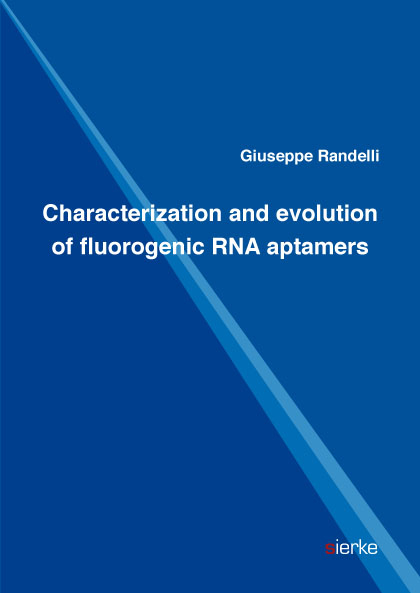
Characterization and evolution of fluorogenic RNA aptamers
Seiten
2019
sierke VERLAG - Sierke WWS GmbH
978-3-96548-028-5 (ISBN)
sierke VERLAG - Sierke WWS GmbH
978-3-96548-028-5 (ISBN)
Fluorogenic aptamers became in recent years a powerful tool in the field of RNA imaging.
This thesis reports the characterization, in vitro selection and engineering of fluorogenic RNA aptamers, with the goal to increase their brightness and expand the scope of accessible emission wavelength. The interaction between 2HBI and the 6-8 aptamer was investigated in great detail. A terbium mediated footprinting was performed to collect folding information of the oligonucleotide and to minimize the sequence. The 6-8 aptamer was also partially randomized and subjected to reselection to find a stable mutant that works in a cellular environment.
A Spinach-based library, containing a randomized binding pocket, was used to find mutants that produce a yellow or red emission instead of the original green one. A combinatorial screening of the randomized positions of the aforementioned library led to the isolation of many active sequences, which have improved features, in terms of ion demand, compared to the parental aptamer.
The fluorescence of Silicon Rhodamine was modulated by conjugation with aptamer ligands. The best results were obtained with the conjugation with 2HBI, which quenches the fluorescence of Silicon Rhodamine, but also modifies its spectroscopic properties. The 6-8 aptamer selectively binds the 2HBI moiety of the conjugate, recovering the NIR fluorescence and further modifying the spectroscopic features of Silicon Rhodamine.
This thesis reports the characterization, in vitro selection and engineering of fluorogenic RNA aptamers, with the goal to increase their brightness and expand the scope of accessible emission wavelength. The interaction between 2HBI and the 6-8 aptamer was investigated in great detail. A terbium mediated footprinting was performed to collect folding information of the oligonucleotide and to minimize the sequence. The 6-8 aptamer was also partially randomized and subjected to reselection to find a stable mutant that works in a cellular environment.
A Spinach-based library, containing a randomized binding pocket, was used to find mutants that produce a yellow or red emission instead of the original green one. A combinatorial screening of the randomized positions of the aforementioned library led to the isolation of many active sequences, which have improved features, in terms of ion demand, compared to the parental aptamer.
The fluorescence of Silicon Rhodamine was modulated by conjugation with aptamer ligands. The best results were obtained with the conjugation with 2HBI, which quenches the fluorescence of Silicon Rhodamine, but also modifies its spectroscopic properties. The 6-8 aptamer selectively binds the 2HBI moiety of the conjugate, recovering the NIR fluorescence and further modifying the spectroscopic features of Silicon Rhodamine.
| Erscheinungsdatum | 19.06.2019 |
|---|---|
| Sprache | englisch |
| Maße | 1480 x 2100 mm |
| Gewicht | 300 g |
| Themenwelt | Naturwissenschaften ► Biologie ► Biochemie |
| Naturwissenschaften ► Chemie | |
| Technik ► Umwelttechnik / Biotechnologie | |
| Schlagworte | Fluorescence modulation • Fluorogenic aptamers • RNA imaging • SELEX • Silicon Rhodamine • Terbium probing |
| ISBN-10 | 3-96548-028-6 / 3965480286 |
| ISBN-13 | 978-3-96548-028-5 / 9783965480285 |
| Zustand | Neuware |
| Haben Sie eine Frage zum Produkt? |
Mehr entdecken
aus dem Bereich
aus dem Bereich


